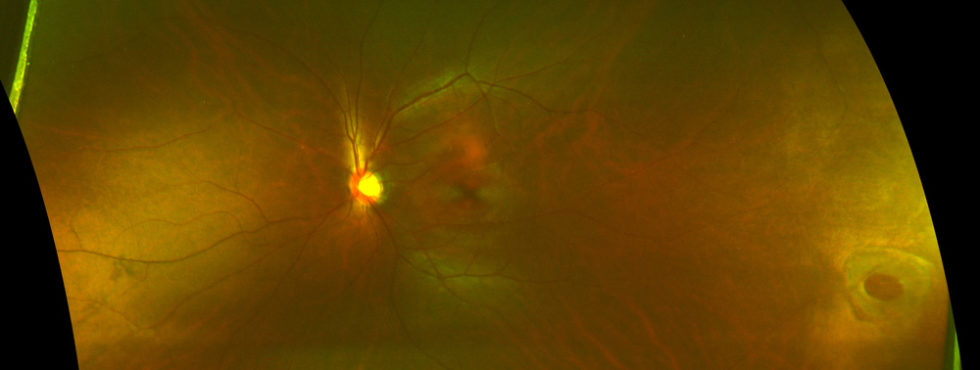


Owing to the large peel area, a rotational pedicle flap was initiated with a FINESSE Flex Loop (Alcon), given the adherent nature of the ILM and the desire to produce a broad hinged flap. Diluted indocyanine green was then injected to identify the ILM and the extent of the previous peel, which had a radius of approximately 4.5 mm from the fovea, extending to the temporal edge of the optic nerve (Figure 1). Diluted triamcinolone was injected to identify retained vitreous, and a close shave of the vitreous base was performed. Trocars were placed in accordance with a standard 3-port 25-gauge PPV. After discussion, the patient agreed to undergo a second surgical attempt to close the hole. OCT imaging of the left eye confirmed the presence of a macular hole with perifoveal cystoid macular edema.

Dilated fundus examination revealed an avitric left eye with a full-thickness macular hole. Slit-lamp examination revealed posterior chamber IOLs in both eyes with an open posterior capsule in the left eye. The patient’s Snellen VA was 20/30 in the right eye and 20/100 in the left eye. Her ocular history also included cataract extraction with implantation of IOLs in both eyes and successful closure of a full-thickness macular hole in her right eye a few months prior. A month earlier, she had undergone a pars plana vitrectomy (PPV) with peeling of the internal limiting membrane (ILM) with sulfur hexafluoride gas endo-tamponade without successful closure of the macular hole. CASE REPORTĪ 59-year-old woman presented for evaluation of a persistent macular hole in her left eye. In this case of a persistent macular hole that failed to close with a primary surgery, we deployed a combination of techniques to achieve anatomical success with improvement in visual acuity. This includes persistent or refractory holes, for which a subsequent surgery typically has a lower success rate than a primary attempt. Since Kelly and Wendell introduced macular hole surgery in the 1990s, 1 numerous innovations and modifications have been introduced, particularly for advanced management of different hole types.


 0 kommentar(er)
0 kommentar(er)
